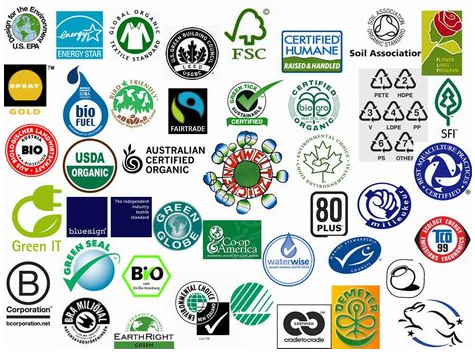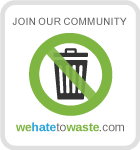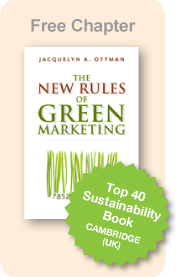Jacquie Ottman's
Green Marketing Blog
How to Choose the Right Eco-label for Your Brand
October 19, 2011 by Jacquelyn Ottman
 Eco-labels are an excellent way to enhance credibility for green marketing claims, but they are not without risk. While 28% of consumers look to green certification seals or labels to confirm that a product adheres to claims, these labels can also confuse. Happily there’s enough method within the madness for marketers to pave a way forward.
Eco-labels are an excellent way to enhance credibility for green marketing claims, but they are not without risk. While 28% of consumers look to green certification seals or labels to confirm that a product adheres to claims, these labels can also confuse. Happily there’s enough method within the madness for marketers to pave a way forward.
Eco-labeling challenges
More than 400 different eco-labels or green certification systems are now on the market. Questions such as which label is better, which product is safer for the environment and what does a label even mean are common questions that well-intended green shoppers may find themselves asking when trying to make an environmentally responsible purchase.
Confusion can arise from labels that certify too much or too little information. Some eco-labels focus on a single product attribute (e.g., recycled content), which keeps things simple but can inadvertently mislead consumers into thinking the product is green overall. Other labels look at several characteristics of a product or even a product’s entire life cycle; such multi-attribute certifications may raise questions about the credibility of a single-attribute certified product while also preventing easy comparisons.
Some products, such as electrical appliances, have a number of labels and certifications, while others, such as mattresses or flatware, have none. Another common reason for confusion is the discrepancy in the levels of rigor applied to some eco-labeling—some require independent, third-party verifications while others allow self-certification.
Here are some important criteria to consider when seeking the labeling most relevant to your brand:
Single-attribute labels
Single-attribute seals focus on one environmental issue, e.g., energy efficiency or sustainable-wood harvesting. Before certification, an independent third-party auditor is typically required to verify that the product meets a publicly available standard.
Many single-attribute labels are sponsored by industry associations looking to defend or capture new markets. Others are sponsored by environmental groups or NGOs that want to protect a natural resource or further a cause. Two single-attribute labels with a global presence are the Forest Stewardship Council (or FSC) label, ensuring the sustainable harvesting of wood and paper, and Fair Trade Certified, ensuring that strict economic, social and environmental criteria were met in the production and trade of such agricultural products as coffee.
Voluntary U.S. government labels
Unlike in some countries, such as Canada, Japan and South Korea, the U.S. government has opted for voluntary single- rather than multi-attribute labels. (The private sector and not-for-profit groups hold sway in the area of multiattribute eco-labeling.) Outside of those associated with independent testing, the government-backed labels don’t involve fees. One of the most visible and influential labels is the U.S. Environmental Protection Agency’s ENERGY STAR (for which we at J. Ottman Consulting were proud to advise over many years).
ENERGY STAR promotes energy efficiency in more than 60 product categories, and almost 3,000 manufactured products now feature the ENERGY STAR label. In fact, according to the Natural Marketing Institute, in 2009, 93% of the American public recognized the ENERGY STAR label and 73% said they would be more likely to purchase products that carried that label.
Other EPA labels include WaterSense, SmartWay (transportation) and Design for Environment (safer chemicals). The USDA stewards the USDA Organic and USDA Certified Biobased labels (another J. Ottman Consulting client).
Multi-attribute labels
As the name suggests, multi-attribute labels examine two or more environmental impacts. Founded in 1989, Green Seal is the granddaddy of them all. It provides a seal of approval for a variety of products that meet specific criteria on a category-by-category basis. Products are reviewed annually for a fee. A few of the organizations whose products now bear the Green Seal certification include Wausau Paper, Clorox, Kimberly-Clark and Hilton.
Other multi-attribute labels exist primarily for specific categories, such as EPEAT in electronics and Global Organic Textile Standards. Still others address specific areas of concern: for instance, the Carbon Trust’s Carbon Reduction label ensuring that the carbon footprint of a product has been measured and is being offset, and the C2C (Cradle to Cradle) label with its emphasis on material chemistry and toxicity. Walmart’s Sustainability Consortium promises to eventually deliver multi-attribute guidance in the form of a Sustainable Product Index.
Self-certification programs
Issued by manufacturers to denote their own environmental and social achievements, self-certification programs do not carry endorsements or the credibility of an impartial third party. However, they do provide distinct advantages in controlling costs and providing flexibility in the type and amount of information provided to consumers. Some self-certification systems showcase labels obtained from government or third-party labeling. Companies that have their own self-certification include NEC Corp. (Eco Products), Sony Ericsson(GreenHeart), General Electric Co. (Ecomagination) and Timberland Co. (Green Index).
Independent claim verification
Independent for-profit organizations, including Scientific Certification Systems, Oakland, Calif., and UL Environment, Northbrook, Ill., will verify specific claims for a fee. They will also develop standards in industries where none exist as well as certify products against standards developed by other organizations.
Environmental product declaration
ISO, the International Organization for Standardization, describes three types of eco-labels: Type I: Environmental Labels; Type II: Environmental Claims and Self-declarations; and Type III: Environmental Product Declarations (EPDs). More often used in Europe and Asia than the U.S., EPDs provide detailed explanations of the full life-cycle impact of a product.
An excellent example is the EPD issued per ISO 14025 by Steelcase for its Think Chair, designed to fit the needs of consumers around the world. Displayed at the company’s website, Steelcase.com, the EPD shares the results of three life-cycle assessments (needed to accurately assess impacts in North America, Europe, and Asia), and describes the various certifications it has received from different countries around the globe.
A way forward
Considering an eco-seal endorsement or independent claim certification for your brand or products? Use these suggestions to avoid confusion and maximize the potential value of an eco-label for your brand/product.
1. Choose wisely
Ensure that the organization behind the seal and its methodologies are credible. In particular, look to see that its standards have been developed in accordance with standards-writing organizations such as ISO and local bodies such as the American National Standards Institute or the British Standards Institute.
2. Be relevant
With so many labels available out there, it is quite likely that your brand may qualify for more than one eco-label and product attribute. Thus, aim to promote the attributes that are most relevant to your brand. Also, remember to integrate your eco-labeling into existing brand platforms. GE’s well-known Ecomagination designation extends from the company’s longstanding “Imagination at Work” brand platform.
3. Educate
Avoid consumer confusion by educating your consumers about the specific criteria upon which your eco-seal is based. When it comes to single-attribute labels, take care to communicate that only a specific product attribute is being certified and that the entire product is not greener as a result. For credibility’s sake, if appropriate, communicate attempts to extend the greening process to other product attributes.
4. Be transparent
If you opt to self-certify, be clear that the label is your own. For example, SC Johnson’s GreenList label was recently taken to task for appearing to be the work of a third party.
5. Promote your eco-label
Considering that many eco-labels are not widely recognized by the average consumer, help to create demand for your eco-label through marketing communication consistent with your seal’s own guidelines. The ENERGY STAR label enjoys strong awareness thanks largely to the promotional efforts of the many manufacturers whose products bear the label coupled with advertising. Be sure to look for opportunities to distinguish your commitment to your selected eco-label from competitors using the same label.
Excerpted from The New Rules of Green Marketing: Strategies, Tools and Inspiration for Sustainable Branding (Berrett-Koehler 2011) by Jacquelyn A. Ottman. Ottman is an expert adviser on green marketing to Fortune 500 companies and the U.S. government. Her firm’s website, containing more information about the book, is http://www.greenmarketing.com.
Originally published in Ad Age Good Works Blog, October 11, 2011.
Recent blog posts:
• Toyota’s Prius: Different Strokes for Different Folks
• Focus on Consumer Self-Interest to Win Today’s Green Customer
Subscribe to Jacquie Ottman’s Green Marketing Blog. Link here.
Learn more about Ottman’s new workshop on November 29-30, 2011, “Profiting from the New Rules of Green Marketing”, here.



 ShareThis
ShareThis

